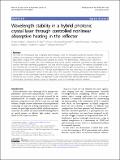Files in this item
Wavelength stability in a hybrid photonic crystal laser through controlled nonlinear absorptive heating in the reflector
Item metadata
| dc.contributor.author | Bakoz, Andrei P. | |
| dc.contributor.author | Liles, Alexandros A. | |
| dc.contributor.author | Gonzalez-Fernandez, Alfredo A. | |
| dc.contributor.author | Habruseva, Tatiana | |
| dc.contributor.author | Hu, Changyu | |
| dc.contributor.author | Viktorov, Evgeny A. | |
| dc.contributor.author | Hegarty, Stephen P. | |
| dc.contributor.author | O’Faolain, Liam | |
| dc.date.accessioned | 2018-08-10T14:30:10Z | |
| dc.date.available | 2018-08-10T14:30:10Z | |
| dc.date.issued | 2018-07-25 | |
| dc.identifier | 255252216 | |
| dc.identifier | 3df888b3-f711-4174-8248-923258e106bb | |
| dc.identifier | 85050646957 | |
| dc.identifier | 000440510500003 | |
| dc.identifier.citation | Bakoz , A P , Liles , A A , Gonzalez-Fernandez , A A , Habruseva , T , Hu , C , Viktorov , E A , Hegarty , S P & O’Faolain , L 2018 , ' Wavelength stability in a hybrid photonic crystal laser through controlled nonlinear absorptive heating in the reflector ' , Light: Science & Applications , vol. 7 , 39 . https://doi.org/10.1038/s41377-018-0043-8 | en |
| dc.identifier.issn | 2047-7538 | |
| dc.identifier.other | RIS: urn:B7AF539BEACB3CBCCDF7327BCB8ADF28 | |
| dc.identifier.other | RIS: Bakoz2018 | |
| dc.identifier.uri | https://hdl.handle.net/10023/15802 | |
| dc.description | This work was supported by the Science Foundation Ireland under Grants SFI12/RC/2276 and 16/ERCS/3838, Engineering and Physical Sciences Research Council (EPSRC) (doctoral grant EP/L505079/1 and equipment grant EP/L017008/1); European Research Council (ERC) (Starting Grant 337508); and Scottish Enterprise. | en |
| dc.description.abstract | The need for miniaturized, fully integrated semiconductor lasers has stimulated significant research efforts into realizing unconventional configurations that can meet the performance requirements of a large spectrum of applications, ranging from communication systems to sensing. We demonstrate a hybrid, silicon photonics-compatible photonic crystal (PhC) laser architecture that can be used to implement cost-effective, high-capacity light sources, with high side-mode suppression ratio and milliwatt output output powers. The emitted wavelength is set and controlled by a silicon PhC cavity-based reflective filter with the gain provided by a III–V-based reflective semiconductor optical amplifier (RSOA). The high power density in the laser cavity results in a significant enhancement of the nonlinear absorption in silicon in the high Q-factor PhC resonator. The heat generated in this manner creates a tuning effect in the wavelength-selective element, which can be used to offset external temperature fluctuations without the use of active cooling. Our approach is fully compatible with existing fabrication and integration technologies, providing a practical route to integrated lasing in wavelength-sensitive schemes. | |
| dc.format.extent | 7 | |
| dc.format.extent | 1181500 | |
| dc.language.iso | eng | |
| dc.relation.ispartof | Light: Science & Applications | en |
| dc.subject | QC Physics | en |
| dc.subject | NDAS | en |
| dc.subject.lcc | QC | en |
| dc.title | Wavelength stability in a hybrid photonic crystal laser through controlled nonlinear absorptive heating in the reflector | en |
| dc.type | Journal article | en |
| dc.contributor.sponsor | EPSRC | en |
| dc.contributor.sponsor | European Research Council | en |
| dc.contributor.institution | University of St Andrews. School of Physics and Astronomy | en |
| dc.contributor.institution | University of St Andrews. Microphotonics and Photonic Crystals Group | en |
| dc.identifier.doi | https://doi.org/10.1038/s41377-018-0043-8 | |
| dc.description.status | Peer reviewed | en |
| dc.identifier.grantnumber | ep/l017008/1 | en |
| dc.identifier.grantnumber | 337508 337508 | en |
This item appears in the following Collection(s)
Items in the St Andrews Research Repository are protected by copyright, with all rights reserved, unless otherwise indicated.

